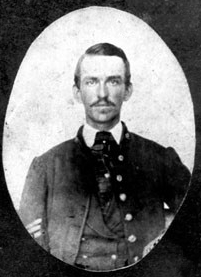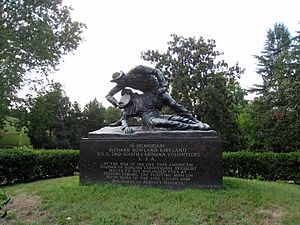Richard Rowland Kirkland facts for kids
Quick facts for kids
Richard Rowland Kirkland
|
|
|---|---|

Monument depicting Kirkland giving water to wounded Union troops at Fredericksburg
|
|
| Nickname(s) | The Angel of Marye's Heights |
| Born | August 1843 Kershaw County, South Carolina, U.S. |
| Died | September 20, 1863 (aged 20) Chickamauga, Georgia, C.S. |
| Buried | |
| Allegiance | |
| Service/ |
|
| Years of service | 1861–1863 |
| Rank | |
| Battles/wars | American Civil War |
Richard Rowland Kirkland (born August 1843 – died September 20, 1863) was a brave soldier during the American Civil War. He was known as "The Angel of Marye's Heights" because of his amazing act of kindness during the Battle of Fredericksburg. He showed great courage and care for others, even his enemies.
Contents
Growing Up: Richard Kirkland's Early Years
Richard Kirkland was born in Flat Rock, in Kershaw County, South Carolina. He was the fifth son of Mary and John Kirkland. Like many kids back then, he received a basic education.
Joining the Army: Kirkland's First Battles
Even though he was young, Kirkland joined the Confederate Army in 1861. This was soon after the war began. He joined before his older brothers did. He was first part of Company E, 2nd South Carolina Volunteer Infantry. Later, he moved to Company G of the same group. He was also promoted to sergeant, a leader of a small group of soldiers.
Kirkland saw his first fighting during the First Battle of Bull Run. This battle is also known as First Manassas. He later fought in the Battle of Savage's Station and the Battle for Maryland Heights. He also fought in the Battle of Antietam. During these battles, many of his close friends from Kershaw County were killed.
The Battle of Fredericksburg: A Story of Kindness
A Heroic Act: Helping Wounded Soldiers
On December 13, 1862, Kirkland's unit was at a stone wall. This wall was at the bottom of "Marye's Heights" near Fredericksburg, Virginia. In the fighting that day, his unit caused many injuries to the attacking Union soldiers.
That night, some wounded soldiers were able to walk to a hospital. But many others were too hurt to move. They had to stay on the battlefield. The next morning, December 14, showed a sad sight. Over 8,000 Union soldiers lay injured in front of the stone wall. Many were still alive but suffering greatly. They were in pain and desperately needed water.
Soldiers from both sides could hear the cries of the wounded. No one dared to go out to help. They feared being shot by the enemy. After hours of listening, Kirkland went to his general. This was Confederate Joseph B. Kershaw, who was also from Kershaw County. Kirkland told him he wanted to help the wounded Union soldiers.
General Kershaw later said he first said no to Kirkland's request. But then he changed his mind. When Kirkland asked if he could wave a white handkerchief as a sign of peace, General Kershaw said no. Kirkland bravely replied, "All right, sir, I'll take my chances."
Kirkland then gathered as many canteens (water bottles) as he could carry. He filled them with water. Then, he walked out onto the battlefield. He went back and forth many times. He gave water to the wounded Union soldiers. He also gave them warm clothing and blankets.
Soldiers from both armies watched him. No one fired a shot. General Kershaw watched Kirkland for more than an hour and a half. At first, he worried the Union side might start shooting. This would cause his own side to shoot back. Kirkland would be caught in the middle.
However, everyone soon understood what Kirkland was doing. According to General Kershaw, cries for water then came from all over the battlefield. Kirkland did not stop. He helped every wounded soldier he could find. This included both Confederate and Union soldiers. Sergeant Kirkland's actions are still a famous story in Fredericksburg today.
Kirkland's Final Battles and Legacy
After Fredericksburg, Kirkland continued to fight. He was in the Battle of Chancellorsville and the Battle of Gettysburg. He showed great courage in these battles. Because of his bravery, he was promoted to lieutenant.
On September 20, 1863, Kirkland was in the Battle of Chickamauga. He and two other men led a charge near "Snodgrass Hill." They realized they had gone too far ahead of their own unit. As they tried to go back, Kirkland was shot. His last words were, "I'm done for... save yourselves and please tell my Pa I died right."
His body was brought back home to Kershaw County, South Carolina. He was buried in the "Old Quaker Cemetery" in Camden. Years later, a friend visited his grave. He said it was a very quiet and hard-to-reach place. General Kershaw was later buried in the same cemetery.
In 1965, a sculptor named Felix de Weldon created a statue. It was placed in front of the stone wall at the Fredericksburg battlefield. This statue honors Kirkland. The Sons of Confederate Veterans later gave Kirkland their Confederate Medal of Honor. This award was created in 1977.



